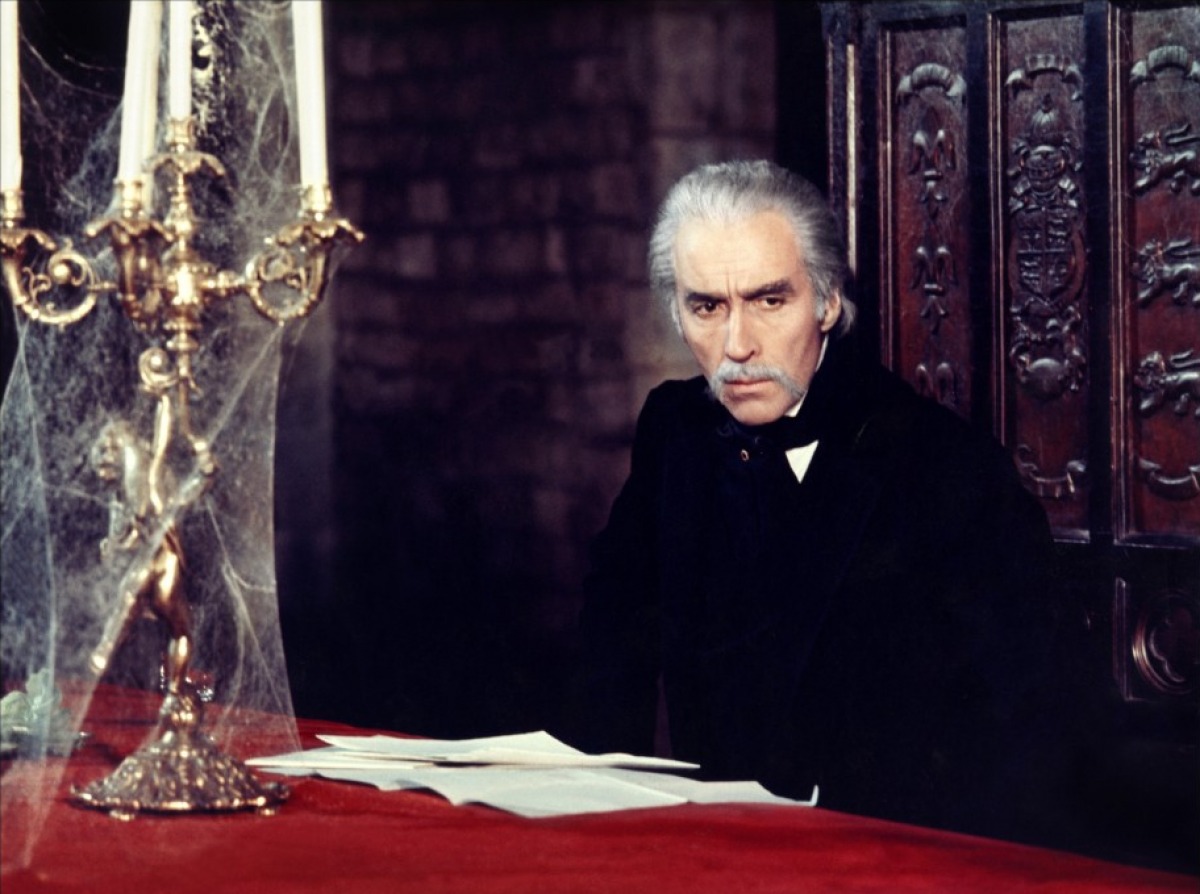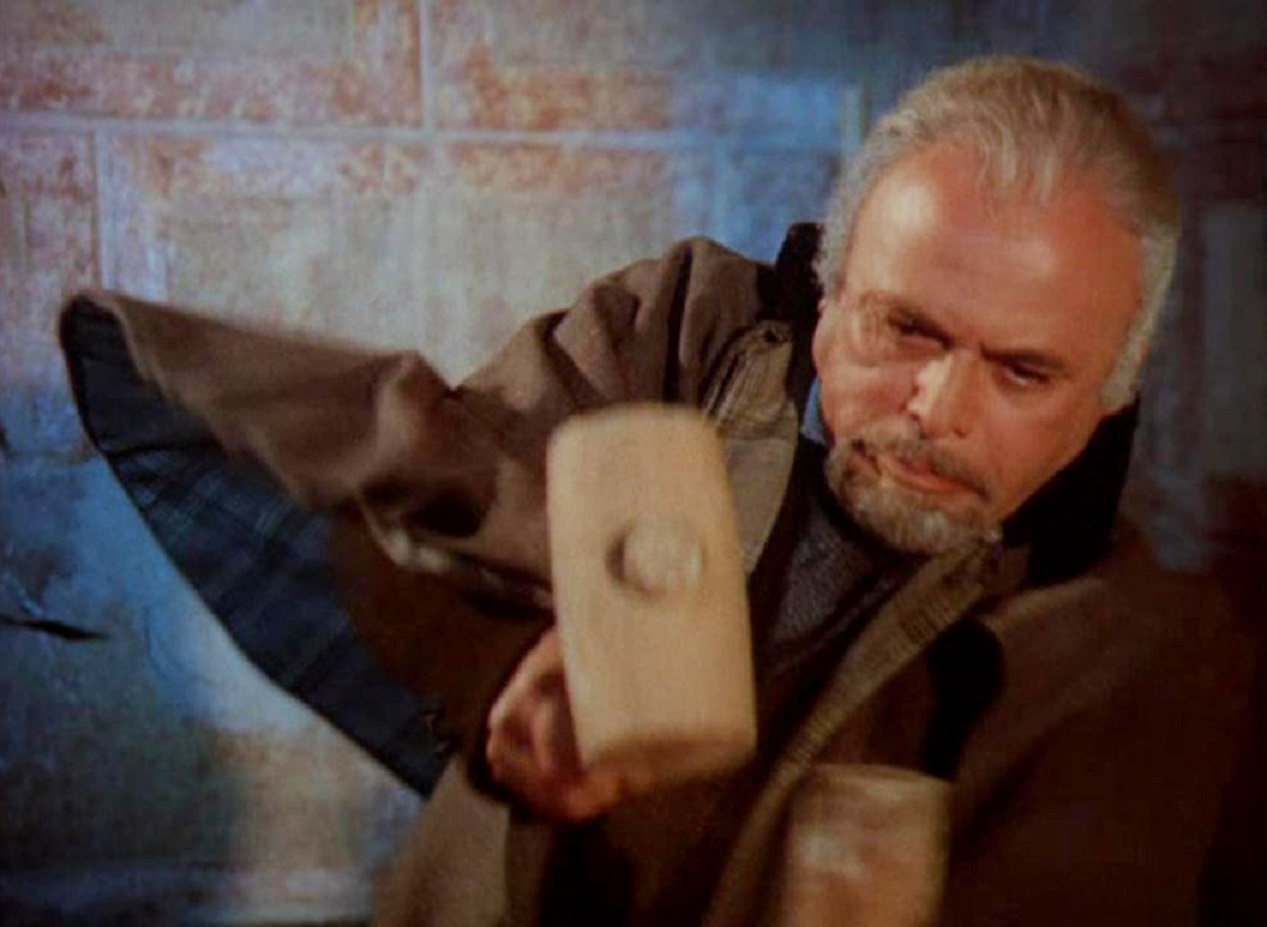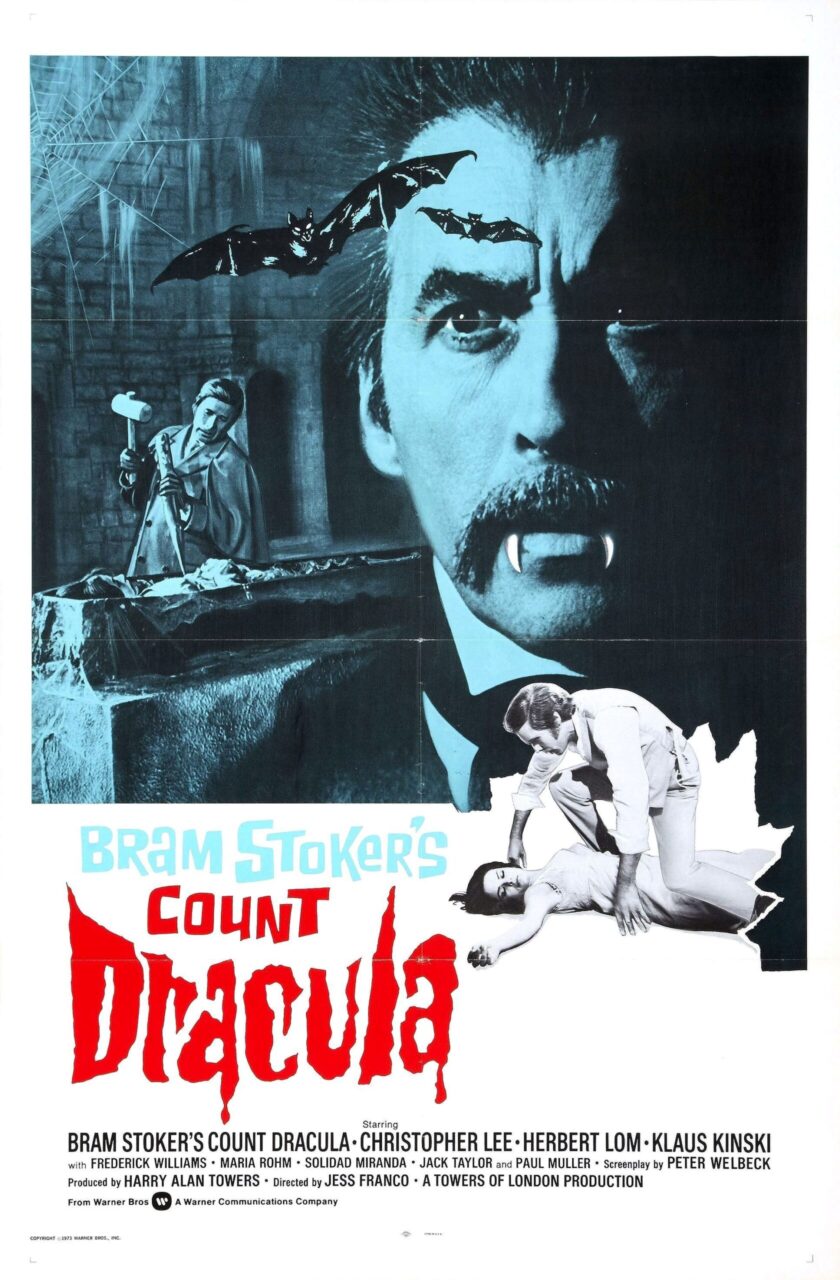(El Conde Dracula)
Spain/Italy/West Germany/Liechtenstein. 1970.
Crew
Director – Jess Franco, Screenplay – Peter Welbeck [Harry Alan Towers], Based on the Novel Dracula by Bram Stoker, Producer – Harry Alan Towers, Photography – Manuel Merino, Music – Bruno Nicolai, Art Direction – George O. Brown. Production Company – Towers of London Productions/Corona Films/Filmar Compagnia Cinematografica/Fenix Cooperative Cinematografica.
Cast
Christopher Lee (Count Dracula), Herbert Lom (Dr Van Helsing), Frederick Williams (Jonathan Harker), Maria Rohm (Mina Murray), Soledad Miranda (Lucy Westenra), Klaus Kinski (Renfield), Jack Taylor (Quincey Morris), Paul Muller (Dr John Seward)
Plot
Lawyer Jonathan Harker travels to Transylvania to transact a property purchase in England for Count Dracula. He ignores the warnings of locals not to go to Dracula’s castle. There Dracula proves to be a vampire and nearly drinks all of Jonathan’s blood before Jonathan makes an escape. Making a recovery at Dr Seward’s sanitarium back in England, Jonathan and occult expert Dr Van Helsing then discover that Dracula is living nearby and is plundering the blood of Jonathan’s fiancee Mina and her best friend Lucy Westenra.
Count Dracula was an interesting production. It was the third official adaptation of Bram Stoker’s Dracula (1897) and was sold with the interesting notion that it was going to film Bram Stoker as written – the two previous versions, the Bela Lugosi Dracula (1931) and Hammer’s Dracula/The Horror of Dracula (1958) with Christopher Lee, had varied considerably from the text. This selling point was certainly enough of a novelty to draw Christopher Lee to the project. Unfortunately, the notion ended about there. It was a good idea that befell bad filmmakers, in the case Harry Alan Towers, a producer responsible for a number of cheap horror films and sexploitation thrillers, and the infamous Jess Franco, a prolific exploitation director. (See below for Jess Franco’s other films).
The film’s claim to adapting Bram Stoker is certainly accurate, although other versions since have reduced the veracity of that claim to the point that Count Dracula does the job no better or worse than they claim to. It accurately follows the Transylvanian sequences, the asylum scenes and the climactic pursuit of Dracula back to Transylvania. Characters such as Dr Seward and Quincey Morris make their first screen appearances in a film adaptation. The film even preserves some of Bram Stoker’s dialogue intact. On the other hand, there are definitely some sequences missing – the Demeter crash is absent, no doubt for budgetary reasons, as well as the eerily ambient climactic scenes where Dracula is tracked using a hypnotised Mina.
Similarly, the very faithfulness to the source material leaves the film inheriting the book’s one great problem – namely that after a great opening, Dracula remains a player who only casts a shadow from off stage. Most other films pad the role out by expanding the number of Dracula’s onscreen appearances but this version does not and as a result, bar the opening, Dracula fairly much vanishes and Christopher Lee is left to a large extent in the same position he was in most of the Hammer Dracula sequels, present but with not a lot to do. Christopher Lee brings his customary dignity to the role – and is outfitted with the one novelty of any screen adaptation, playing a Dracula who progressively gets younger as Bram Stoker described in the book.

Certainly, among Jess Franco’s extraordinarily prolific output (nearly 200 films), Count Dracula is one of his better works. The first 15-20 minutes are some of most atmospheric moments of Franco’s directorial career – the moody journey through Transylvania; the scenes with Jonathan being picked up by a coach and Dracula as the coachman stopping to ward off marauding wolves; the two of them dining in an echoingly empty hall; Dracula’s impassioned recitation of his family history.
Unfortunately, Franco, as though having exhausted himself in such concerted effort, then lets the film fall away to indifference. The two next scenes, which are stand-out set-pieces in the book – where Dracula’s wives attempt to seduce Jonathan and Dracula’s wall-climbing trick – are conducted with dreary disinterest. As the film keeps going, the more that Franco’s usual pedestrian cheapness affects the exercise. A scene invented over the book that tries to build something threatening up out of frenetic crosscutting between closeups of stuffed birds is woeful.
The one interesting contrast between this and the Hammer Dracula is how much of a continental Dracula rather than a specifically English Dracula that this is. Count Dracula was made as a co-production between several European countries. Hammer’s florid stagebound dramatics and even Stoker’s gloomy coastal English locations have been replaced by a distinctive Spanish Old World feel – set in and around Spanish buildings, churches and graveyards – which provides a very different atmosphere to the story. Equally noticeable is the non-Anglicised cast – most glaringly obvious being the casting of the character of the Texan Quincey with the distinctly Teutonic Jack Taylor.

In the end, Count Dracula is a noble endeavour that has befallen a cheap producer and a hack director. Had the same exercise been made with one of the contemporary continental directors such as Mario Bava or Riccardo Freda at the helm we could have had a potential classic on our hands.
Other adaptations of Dracula are:– Nosferatu (1922); Dracula (1931) with Bela Lugosi; the Spanish language version Dracula (1931) shot on the same sets as the Lugosi version starring Carlos Villarias; Hammer’s classic Dracula/The Horror of Dracula (1958) with Christopher Lee; Dracula in Pakistan (1967), an uncredited remake of the Hammer film; Dan Curtis’s tv movie Dracula (1974), starring Jack Palance; the BBC mini-series Count Dracula (1977), with Louis Jourdan; Dracula (1979) with Frank Langella; Werner Herzog’s Nosferatu the Vampyre (1979) with Klaus Kinski; Francis Ford Coppola’s Bram Stoker’s Dracula (1992) with Gary Oldman; the modernised Italian-German adaptation Dracula (2002) with Patrick Bergin; Guy Maddin’s ballet adaptation Dracula: Pages from a Virgin’s Diary (2002); the BBC tv movie Dracula (2006) with Marc Warren; the low-budget modernised Dracula (2009); Dario Argento’s Dracula (2012) with Thomas Kretschmann as Dracula; the low-budget Canadian Terror of Dracula (2012) with director Anthony D.P. Mann as Dracula; the tv series Dracula (2013-4) with Jonathan Rhys Meyers; the BBC mini-series Dracula (2020) starring Claes Bang; Bram Stoker’s Van Helsing (2021), which actually features no Dracula; The Asylum’s Dracula: The Original Living Vampire (2022) with Jake Herbert, which actually features no Dracula; the remake of Nosferatu (2024) with Bill Skarsgård; and Luc Besson’s Dracula: A Love Tale (2025).
Jess Franco’s other genre films are:– The Awful Dr Orloff (1962), The Sadistic Baron Von Klaus (1962), The Secret of Dr Orloff (1964), Attack of the Robots (1966), The Diabolical Dr Z/Miss Death (1966), The Blood of Fu Manchu (1968), Necronomicon/Succubus (1968), The Castle of Fu Manchu (1969), Justine (1969), Kiss Me Monster (1969), 99 Women (1969), Sadisterotica/Red Lips (1969), The Girl from Rio (1969), Venus in Furs/Paroxysmus (1969), The Bloody Judge/Night of the Blood Monster (1970), Eugenie/Philosophy in the Boudoir (1970), Nightmares Come at Night (1970), Vampyros Lesbos (1970), Dracula, Prisoner of Frankenstein (1972), She Killed in Ecstasy (1971), The Corpse Packs His Bags (1972), The Daughter of Dracula (1972), The Demons (1972), Doctor Mabuse (1972), Dracula, Prisoner of Frankenstein (1972), The Erotic Adventures of Frankenstein (1972), The Silence of the Tomb (1972), The Bare-Breasted Countess/Erotikill/Female Vampire (1973), The Erotic Adventures of Maciste in Atlantis (1973), The Obscene Mirror/The Other Side of the Mirror (1973), The Sinister Eyes of Dr Orloff (1973), A Virgin Among the Living Dead/Christina, Princess of Eroticism (1973), Lorna the Exorcist (1974), Night of the Assassins/Night of the Skull (1974), The Perverse Countess (1974), Eugenie (1975), Doriana Grey (1976), Jack the Ripper (1976), Sexy Sisters/Satanic Sisters (1976), Greta the Mad Butcher/Wanda the Wicked Warden/Ilsa: Absolute Power (1977), Call of the Blonde Goddess/Voodoo Passion (1977), Wicked Women (1977), Demoniac/Exorcism/The Ripper of Notre Dame (1979), Man Hunter/The Devil Hunter (1980), White Cannibal Queen (1980), Bloody Moon (1981), Oasis of the Zombies (1981), Revenge of the House of Usher (1982), Grave of the Living Dead (1983), The Treasure of the White Goddess (1983), The Sinister Dr Orloff (1984), Mansion of the Living Dead (1985), Faceless (1987), The Killer Barbies (1996), Lust for Frankenstein (1998), Marie-Cookie and the Killer Tarantula in 8 Legs to Love You (1998), Tender Flesh (1998), Vampire Blues (1999), Vampire Junction (2001), Incubus (2002), Killer Barbies vs Dracula (2002), Snakewoman (2005), Paula-Paula (2010), Al Pereira vs the Alligator Ladies (2012), Crypt of the Condemned (2012) and Revenge of the Alligator Ladies (2013).
Trailer here


